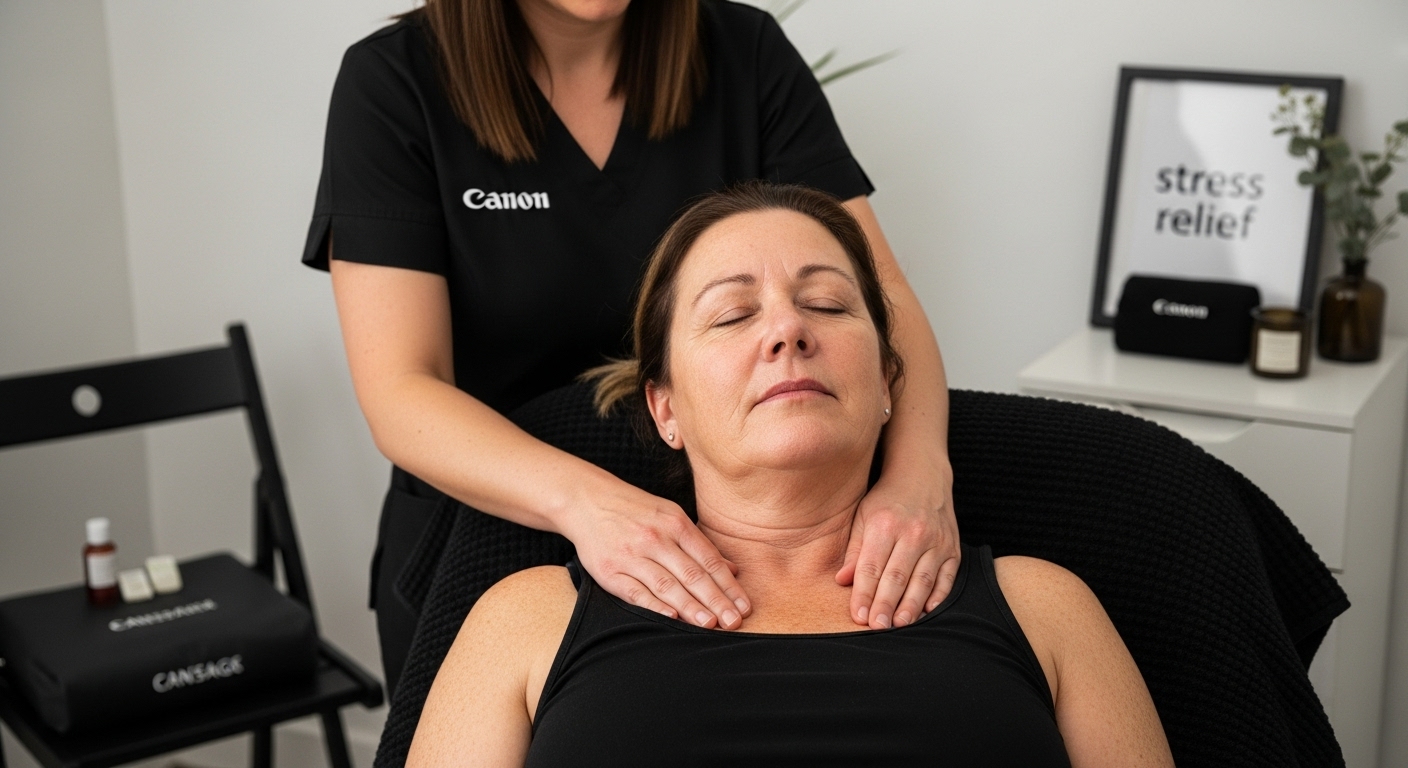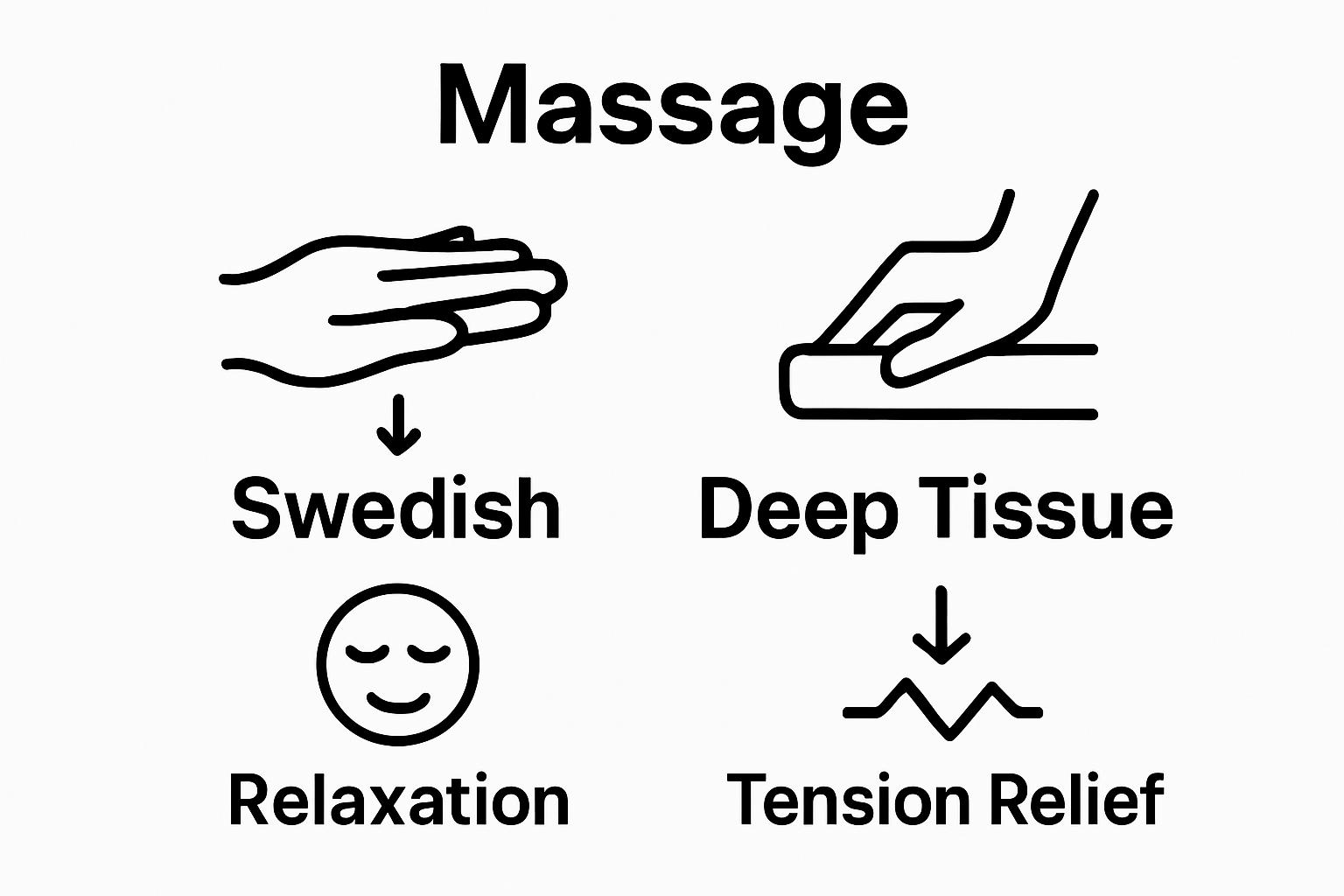Massage therapy sounds like pure relaxation and a treat you give yourself when you need a break. But the numbers reveal something much bigger. Clinical studies show regular massage therapy can significantly lower cortisol levels while increasing serotonin and dopamine. So this is not just about comfort or pampering. It is a powerful, research-backed way to reduce stress, improve your immune system, and recharge your mind and body.
Table of Contents
- What Is Massage Therapy And Its Benefits?
- Why Massage Matters For Stress Relief And Health
- The Science Behind How Massage Therapy Works
- Key Concepts Of Different Massage Techniques
- Selecting The Right Therapist For Your Needs
Quick Summary
| Takeaway | Explanation |
|---|---|
| Massage therapy alleviates muscle tension and pain. | Regular sessions reduce chronic pain and promote relaxation, enhancing overall physical well-being. |
| It helps manage stress and anxiety effectively. | Therapeutic massage lowers cortisol levels and increases the production of feel-good neurotransmitters like serotonin. |
| Different techniques target specific needs. | Techniques such as Swedish or Deep Tissue Massage cater to individual wellness goals, allowing for customized care. |
| Choosing a qualified therapist is essential. | Look for registered therapists with credentials and experience in specific modalities for the best results. |
| Massage supports immune system functioning. | Regular therapy sessions can enhance immune response, contributing to better overall health and resilience against illnesses. |
What is Massage Therapy and Its Benefits?
Massage therapy is a holistic healing practice that involves systematically manipulating soft tissues in the human body to promote physical and mental wellness. Through strategic hand movements, pressure techniques, and body positioning, registered massage therapists work to alleviate muscle tension, improve circulation, and support overall health.
Understanding the Fundamentals of Massage Therapy
Research from the National Center for Complementary and Integrative Health reveals massage therapy as a comprehensive approach to wellness that extends far beyond simple relaxation. At its core, massage therapy involves manipulating muscles, tendons, ligaments, and connective tissues through various techniques designed to address specific physical and emotional needs.
Key benefits of professional massage therapy include:
- Reducing muscle tension and chronic pain
- Improving blood circulation and lymphatic drainage
- Decreasing stress and anxiety levels
- Enhancing overall flexibility and range of motion
- Supporting immune system functioning
Holistic Wellness Through Therapeutic Touch
Massage therapy is not just a luxury treatment but a scientifically recognized method of healing. Clinical studies from Mayo Clinic suggest that therapeutic massage can help manage conditions like fibromyalgia, headaches, and stress-related insomnia. By engaging the body’s natural healing mechanisms, massage therapists help clients restore balance and promote deep physiological recovery.
For those interested in exploring more specialized techniques, our guide on Stretch & Restore provides deeper insights into targeted massage approaches that complement overall wellness strategies. Whether you are seeking relief from chronic pain or simply wanting to enhance your body’s natural healing potential, massage therapy offers a powerful, non-invasive path to improved health and well-being.
Why Massage Matters for Stress Relief and Health
Stress has become an increasingly prevalent challenge in modern life, impacting physical and mental well-being in profound ways. Massage therapy emerges as a powerful, scientifically supported intervention for managing stress and promoting holistic health, offering more than just momentary relaxation.
The Physiological Impact of Stress and Healing
Research from the National Institutes of Health demonstrates that massage therapy significantly reduces cortisol levels while increasing positive neurotransmitters like serotonin and dopamine. This hormonal shift creates a powerful mechanism for stress reduction and emotional regulation.
Key physiological benefits of massage for stress management include:
- Lowering elevated stress hormone levels
- Reducing muscle tension associated with chronic stress
- Promoting deeper, more restorative sleep patterns
- Supporting improved emotional regulation
- Enhancing overall nervous system balance
Holistic Wellness Through Therapeutic Intervention
Massage is not merely a temporary comfort but a comprehensive approach to health maintenance. Clinical studies reveal that regular massage therapy can substantially improve immune function, decrease anxiety symptoms, and support the body’s natural healing mechanisms.
For individuals seeking specialized stress relief techniques, our guide on Swedish vs. Deep Tissue Massage offers insights into selecting the most appropriate massage approach for individual stress management needs. By understanding the intricate connections between touch, physiological responses, and emotional well-being, massage therapy provides a natural, non-invasive pathway to enhanced health and resilience.

The Science Behind How Massage Therapy Works
Massage therapy is far more than a relaxing experience; it is a complex physiological intervention that triggers sophisticated biological responses within the human body.
By understanding the intricate mechanisms behind therapeutic touch, we can appreciate how massage profoundly impacts physical and mental wellness.
Neurological and Biochemical Responses
Scientific research from the National Institutes of Health reveals that massage stimulates pressure receptors and directly influences the autonomic nervous system. This neurological interaction creates significant analgesic and calming effects by modulating the body’s stress response and enhancing parasympathetic nervous system activity.
Key neurological mechanisms triggered by massage include:
- Activation of sensory nerve receptors
- Reduction of stress hormone production
- Stimulation of endorphin and serotonin release
- Modulation of pain perception pathways
- Enhancement of overall nervous system communication
Cellular and Physiological Healing Processes
Research published in the Journal of Physiological Sciences demonstrates that massage therapy can reduce inflammation and promote mitochondrial biogenesis in skeletal muscle. These cellular-level changes support tissue recovery, improve metabolic function, and contribute to overall physical resilience.
For those interested in exploring deeper therapeutic techniques, our guide on Deep Tissue Massage provides insights into specialized approaches that leverage these intricate physiological mechanisms. By understanding the scientific foundations of massage, individuals can appreciate it as a sophisticated, evidence-based approach to holistic health management.
For better clarity on how massage therapy impacts the body, this table summarizes the main physiological and neurological effects of massage as described in the article.
| Effect Type | Description | Result/Benefit |
|---|---|---|
| Hormonal | Lowers cortisol; increases serotonin and dopamine | Reduces stress, improves mood, emotional regulation |
| Neurological | Stimulates pressure and sensory nerve receptors | Promotes relaxation, pain modulation, nervous system balance |
| Physiological | Enhances circulation, lymphatic drainage | Supports tissue healing, reduces inflammation |
| Cellular | Promotes mitochondrial biogenesis, tissue repair | Increases physical resilience, aids recovery |
Key Concepts of Different Massage Techniques
Massage therapy encompasses a diverse range of techniques, each designed to address specific physical and emotional needs. Understanding these varied approaches allows individuals to select the most appropriate method for their unique wellness goals and body requirements.
Fundamental Massage Modalities
According to the American Massage Therapy Association, massage techniques can be broadly categorized based on their primary therapeutic objectives and technical approaches. These modalities range from gentle, relaxation-focused methods to more intensive, therapeutic interventions.
Key massage techniques include:
- Swedish Massage: Focused on overall relaxation and circulation
- Deep Tissue Massage: Targeting chronic muscle tension and structural imbalances
- Sports Massage: Designed for athletic performance and recovery
- Trigger Point Therapy: Addressing specific muscle knots and tension areas
- Myofascial Release: Working with connective tissue to improve mobility
Technical Variations and Therapeutic Intentions
Each massage technique employs unique approaches to manipulating soft tissues. Some utilize long, flowing strokes to promote relaxation, while others apply concentrated pressure to release deep-seated muscle tension. Medical research from industry experts highlights that the effectiveness of a massage technique depends on its alignment with the client’s specific physical condition and wellness objectives.
For those interested in exploring specialized massage approaches, our guide on Swedish Massage Therapy provides deeper insights into one of the most fundamental and versatile massage techniques. By understanding these nuanced approaches, clients can make informed decisions about their therapeutic bodywork journey, selecting methods that best support their individual health and wellness goals.
To help readers compare the most common massage techniques and understand their intended benefits, the following table summarizes key modalities discussed in the article.
| Massage Technique | Purpose/Focus | Key Benefits |
|---|---|---|
| Swedish Massage | Relaxation, improved circulation | Reduces tension, promotes relaxation, supports overall wellness |
| Deep Tissue Massage | Chronic muscle tension, structural issues | Relieves deep-seated pain, addresses postural imbalances |
| Sports Massage | Athletic performance, recovery | Increases mobility, speeds recovery, reduces risk of injury |
| Trigger Point Therapy | Muscle knots and specific tension areas | Releases localized pain and tension |
| Myofascial Release | Connective tissue, improved mobility | Enhances flexibility, reduces fascia restrictions |

Selecting the Right Therapist for Your Needs
Choosing a massage therapist is a deeply personal decision that involves careful consideration of professional credentials, therapeutic expertise, and individual wellness goals. The right therapist can transform your approach to physical and mental health, providing personalized care that addresses your unique physiological requirements.
Professional Credentials and Qualifications
According to the Mayo Clinic, effective communication and professional background are crucial when selecting a massage therapist. Clients should prioritize registered massage therapists with verifiable credentials, specialized training, and a comprehensive understanding of human anatomy and therapeutic techniques.
Key factors to consider when selecting a massage therapist include:
- Verified professional certification and licensing
- Specialized training in specific massage modalities
- Experience treating conditions similar to your health needs
- Demonstrated understanding of holistic wellness approaches
- Positive client testimonials and professional references
Personalized Consultation and Communication
A quality massage therapist recognizes that each client’s body and wellness journey is unique. Initial consultations should involve comprehensive discussions about medical history, current physical conditions, stress levels, and specific therapeutic objectives. This collaborative approach ensures that the massage technique is precisely tailored to individual requirements.
For individuals seeking a personalized and professional therapeutic experience, our guide on Myofascial Release Therapy offers deeper insights into specialized massage approaches. By understanding the importance of professional expertise and personalized care, clients can make informed decisions that support their holistic health and wellness goals.
Discover Lasting Balance Through Personalized Massage Therapy in Toronto
If you are searching for real solutions to muscle tension, chronic pain, or ongoing stress after reading about the benefits and techniques in massage therapy, you are not alone. Many people feel frustrated by temporary relief and generic treatments that fail to address their unique wellness needs. The article highlights how personalized care, understanding specific techniques like Swedish massage or myofascial release, and finding an expert Registered Massage Therapist can make all the difference in your journey to better health.

Choose wellness that lasts. At Verdure Registered Massage Therapy, our Toronto-based team offers tailored sessions designed to give you real relief and holistic improvement. Explore a wide range of therapeutic services including Swedish massage, myofascial release, and more—all delivered by caring, professional RMTs. Book your personalized session today and experience skilled touch that addresses your specific challenges. Begin your path to restored balance by visiting https://verduretoronto.com now.
Frequently Asked Questions
What are the main benefits of massage therapy?
Massage therapy offers numerous benefits, including reducing muscle tension and chronic pain, improving blood circulation, decreasing stress and anxiety levels, enhancing flexibility, and supporting immune system functioning.
How does massage therapy help with stress management?
Massage therapy helps manage stress by lowering cortisol levels and increasing serotonin and dopamine, promoting relaxation, reducing muscle tension associated with stress, and improving emotional regulation.
What techniques are commonly used in massage therapy?
Common techniques in massage therapy include Swedish massage for relaxation, deep tissue massage for chronic tension, sports massage for athletes, trigger point therapy for specific muscle knots, and myofascial release to improve mobility.
How should I choose the right massage therapist for my needs?
When selecting a massage therapist, consider their professional credentials, specialized training in relevant techniques, experience with similar conditions, and ensure they engage in personal consultations to tailor the treatment to your specific needs.
